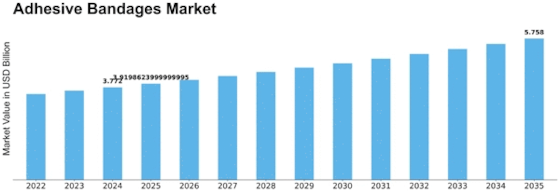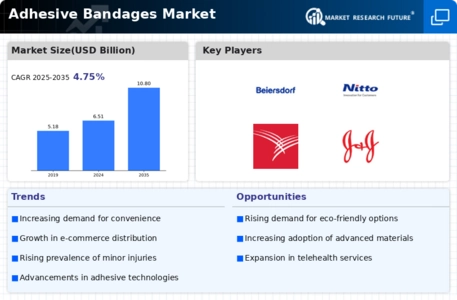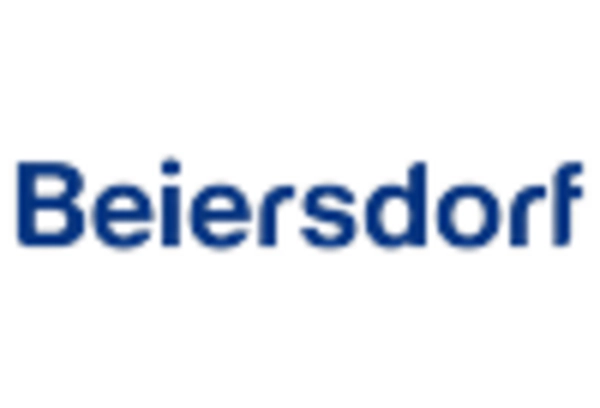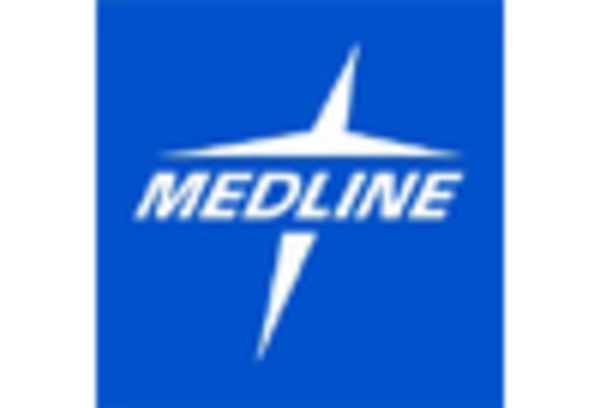Wound Care
Surgical
Sports Injuries
Burns
Other
Fabric
Plastic
Foam
Hydrocolloid
Transparent
Standard Adhesive Bandages
Waterproof Adhesive Bandages
Antibacterial Adhesive Bandages
Gauze Adhesive Bandages
Pharmacies
Supermarkets/Hypermarkets
Online Stores
Convenience Stores
North America
Europe
South America
Asia Pacific
Middle East and Africa
North America Outlook (USD Billion, 2019-2035)
North America Adhesive Bandages Market by Application Type
Wound Care
Surgical
Sports Injuries
Burns
Other
North America Adhesive Bandages Market by Material Type
Fabric
Plastic
Foam
Hydrocolloid
Transparent
North America Adhesive Bandages Market by Product Type
Standard Adhesive Bandages
Waterproof Adhesive Bandages
Antibacterial Adhesive Bandages
Gauze Adhesive Bandages
North America Adhesive Bandages Market by Distribution Channel Type
Pharmacies
Supermarkets/Hypermarkets
Online Stores
Convenience Stores
North America Adhesive Bandages Market by Regional Type
US
Canada
US Outlook (USD Billion, 2019-2035)
US Adhesive Bandages Market by Application Type
Wound Care
Surgical
Sports Injuries
Burns
Other
US Adhesive Bandages Market by Material Type
Fabric
Plastic
Foam
Hydrocolloid
Transparent
US Adhesive Bandages Market by Product Type
Standard Adhesive Bandages
Waterproof Adhesive Bandages
Antibacterial Adhesive Bandages
Gauze Adhesive Bandages
US Adhesive Bandages Market by Distribution Channel Type
Pharmacies
Supermarkets/Hypermarkets
Online Stores
Convenience Stores
CANADA Outlook (USD Billion, 2019-2035)
CANADA Adhesive Bandages Market by Application Type
Wound Care
Surgical
Sports Injuries
Burns
Other
CANADA Adhesive Bandages Market by Material Type
Fabric
Plastic
Foam
Hydrocolloid
Transparent
CANADA Adhesive Bandages Market by Product Type
Standard Adhesive Bandages
Waterproof Adhesive Bandages
Antibacterial Adhesive Bandages
Gauze Adhesive Bandages
CANADA Adhesive Bandages Market by Distribution Channel Type
Pharmacies
Supermarkets/Hypermarkets
Online Stores
Convenience Stores
Europe Outlook (USD Billion, 2019-2035)
Europe Adhesive Bandages Market by Application Type
Wound Care
Surgical
Sports Injuries
Burns
Other
Europe Adhesive Bandages Market by Material Type
Fabric
Plastic
Foam
Hydrocolloid
Transparent
Europe Adhesive Bandages Market by Product Type
Standard Adhesive Bandages
Waterproof Adhesive Bandages
Antibacterial Adhesive Bandages
Gauze Adhesive Bandages
Europe Adhesive Bandages Market by Distribution Channel Type
Pharmacies
Supermarkets/Hypermarkets
Online Stores
Convenience Stores
Europe Adhesive Bandages Market by Regional Type
Germany
UK
France
Russia
Italy
Spain
Rest of Europe
GERMANY Outlook (USD Billion, 2019-2035)
GERMANY Adhesive Bandages Market by Application Type
Wound Care
Surgical
Sports Injuries
Burns
Other
GERMANY Adhesive Bandages Market by Material Type
Fabric
Plastic
Foam
Hydrocolloid
Transparent
GERMANY Adhesive Bandages Market by Product Type
Standard Adhesive Bandages
Waterproof Adhesive Bandages
Antibacterial Adhesive Bandages
Gauze Adhesive Bandages
GERMANY Adhesive Bandages Market by Distribution Channel Type
Pharmacies
Supermarkets/Hypermarkets
Online Stores
Convenience Stores
UK Outlook (USD Billion, 2019-2035)
UK Adhesive Bandages Market by Application Type
Wound Care
Surgical
Sports Injuries
Burns
Other
UK Adhesive Bandages Market by Material Type
Fabric
Plastic
Foam
Hydrocolloid
Transparent
UK Adhesive Bandages Market by Product Type
Standard Adhesive Bandages
Waterproof Adhesive Bandages
Antibacterial Adhesive Bandages
Gauze Adhesive Bandages
UK Adhesive Bandages Market by Distribution Channel Type
Pharmacies
Supermarkets/Hypermarkets
Online Stores
Convenience Stores
FRANCE Outlook (USD Billion, 2019-2035)
FRANCE Adhesive Bandages Market by Application Type
Wound Care
Surgical
Sports Injuries
Burns
Other
FRANCE Adhesive Bandages Market by Material Type
Fabric
Plastic
Foam
Hydrocolloid
Transparent
FRANCE Adhesive Bandages Market by Product Type
Standard Adhesive Bandages
Waterproof Adhesive Bandages
Antibacterial Adhesive Bandages
Gauze Adhesive Bandages
FRANCE Adhesive Bandages Market by Distribution Channel Type
Pharmacies
Supermarkets/Hypermarkets
Online Stores
Convenience Stores
RUSSIA Outlook (USD Billion, 2019-2035)
RUSSIA Adhesive Bandages Market by Application Type
Wound Care
Surgical
Sports Injuries
Burns
Other
RUSSIA Adhesive Bandages Market by Material Type
Fabric
Plastic
Foam
Hydrocolloid
Transparent
RUSSIA Adhesive Bandages Market by Product Type
Standard Adhesive Bandages
Waterproof Adhesive Bandages
Antibacterial Adhesive Bandages
Gauze Adhesive Bandages
RUSSIA Adhesive Bandages Market by Distribution Channel Type
Pharmacies
Supermarkets/Hypermarkets
Online Stores
Convenience Stores
ITALY Outlook (USD Billion, 2019-2035)
ITALY Adhesive Bandages Market by Application Type
Wound Care
Surgical
Sports Injuries
Burns
Other
ITALY Adhesive Bandages Market by Material Type
Fabric
Plastic
Foam
Hydrocolloid
Transparent
ITALY Adhesive Bandages Market by Product Type
Standard Adhesive Bandages
Waterproof Adhesive Bandages
Antibacterial Adhesive Bandages
Gauze Adhesive Bandages
ITALY Adhesive Bandages Market by Distribution Channel Type
Pharmacies
Supermarkets/Hypermarkets
Online Stores
Convenience Stores
SPAIN Outlook (USD Billion, 2019-2035)
SPAIN Adhesive Bandages Market by Application Type
Wound Care
Surgical
Sports Injuries
Burns
Other
SPAIN Adhesive Bandages Market by Material Type
Fabric
Plastic
Foam
Hydrocolloid
Transparent
SPAIN Adhesive Bandages Market by Product Type
Standard Adhesive Bandages
Waterproof Adhesive Bandages
Antibacterial Adhesive Bandages
Gauze Adhesive Bandages
SPAIN Adhesive Bandages Market by Distribution Channel Type
Pharmacies
Supermarkets/Hypermarkets
Online Stores
Convenience Stores
REST OF EUROPE Outlook (USD Billion, 2019-2035)
REST OF EUROPE Adhesive Bandages Market by Application Type
Wound Care
Surgical
Sports Injuries
Burns
Other
REST OF EUROPE Adhesive Bandages Market by Material Type
Fabric
Plastic
Foam
Hydrocolloid
Transparent
REST OF EUROPE Adhesive Bandages Market by Product Type
Standard Adhesive Bandages
Waterproof Adhesive Bandages
Antibacterial Adhesive Bandages
Gauze Adhesive Bandages
REST OF EUROPE Adhesive Bandages Market by Distribution Channel Type
Pharmacies
Supermarkets/Hypermarkets
Online Stores
Convenience Stores
APAC Outlook (USD Billion, 2019-2035)
APAC Adhesive Bandages Market by Application Type
Wound Care
Surgical
Sports Injuries
Burns
Other
APAC Adhesive Bandages Market by Material Type
Fabric
Plastic
Foam
Hydrocolloid
Transparent
APAC Adhesive Bandages Market by Product Type
Standard Adhesive Bandages
Waterproof Adhesive Bandages
Antibacterial Adhesive Bandages
Gauze Adhesive Bandages
APAC Adhesive Bandages Market by Distribution Channel Type
Pharmacies
Supermarkets/Hypermarkets
Online Stores
Convenience Stores
APAC Adhesive Bandages Market by Regional Type
China
India
Japan
South Korea
Malaysia
Thailand
Indonesia
Rest of APAC
CHINA Outlook (USD Billion, 2019-2035)
CHINA Adhesive Bandages Market by Application Type
Wound Care
Surgical
Sports Injuries
Burns
Other
CHINA Adhesive Bandages Market by Material Type
Fabric
Plastic
Foam
Hydrocolloid
Transparent
CHINA Adhesive Bandages Market by Product Type
Standard Adhesive Bandages
Waterproof Adhesive Bandages
Antibacterial Adhesive Bandages
Gauze Adhesive Bandages
CHINA Adhesive Bandages Market by Distribution Channel Type
Pharmacies
Supermarkets/Hypermarkets
Online Stores
Convenience Stores
INDIA Outlook (USD Billion, 2019-2035)
INDIA Adhesive Bandages Market by Application Type
Wound Care
Surgical
Sports Injuries
Burns
Other
INDIA Adhesive Bandages Market by Material Type
Fabric
Plastic
Foam
Hydrocolloid
Transparent
INDIA Adhesive Bandages Market by Product Type
Standard Adhesive Bandages
Waterproof Adhesive Bandages
Antibacterial Adhesive Bandages
Gauze Adhesive Bandages
INDIA Adhesive Bandages Market by Distribution Channel Type
Pharmacies
Supermarkets/Hypermarkets
Online Stores
Convenience Stores
JAPAN Outlook (USD Billion, 2019-2035)
JAPAN Adhesive Bandages Market by Application Type
Wound Care
Surgical
Sports Injuries
Burns
Other
JAPAN Adhesive Bandages Market by Material Type
Fabric
Plastic
Foam
Hydrocolloid
Transparent
JAPAN Adhesive Bandages Market by Product Type
Standard Adhesive Bandages
Waterproof Adhesive Bandages
Antibacterial Adhesive Bandages
Gauze Adhesive Bandages
JAPAN Adhesive Bandages Market by Distribution Channel Type
Pharmacies
Supermarkets/Hypermarkets
Online Stores
Convenience Stores
SOUTH KOREA Outlook (USD Billion, 2019-2035)
SOUTH KOREA Adhesive Bandages Market by Application Type
Wound Care
Surgical
Sports Injuries
Burns
Other
SOUTH KOREA Adhesive Bandages Market by Material Type
Fabric
Plastic
Foam
Hydrocolloid
Transparent
SOUTH KOREA Adhesive Bandages Market by Product Type
Standard Adhesive Bandages
Waterproof Adhesive Bandages
Antibacterial Adhesive Bandages
Gauze Adhesive Bandages
SOUTH KOREA Adhesive Bandages Market by Distribution Channel Type
Pharmacies
Supermarkets/Hypermarkets
Online Stores
Convenience Stores
MALAYSIA Outlook (USD Billion, 2019-2035)
MALAYSIA Adhesive Bandages Market by Application Type
Wound Care
Surgical
Sports Injuries
Burns
Other
MALAYSIA Adhesive Bandages Market by Material Type
Fabric
Plastic
Foam
Hydrocolloid
Transparent
MALAYSIA Adhesive Bandages Market by Product Type
Standard Adhesive Bandages
Waterproof Adhesive Bandages
Antibacterial Adhesive Bandages
Gauze Adhesive Bandages
MALAYSIA Adhesive Bandages Market by Distribution Channel Type
Pharmacies
Supermarkets/Hypermarkets
Online Stores
Convenience Stores
THAILAND Outlook (USD Billion, 2019-2035)
THAILAND Adhesive Bandages Market by Application Type
Wound Care
Surgical
Sports Injuries
Burns
Other
THAILAND Adhesive Bandages Market by Material Type
Fabric
Plastic
Foam
Hydrocolloid
Transparent
THAILAND Adhesive Bandages Market by Product Type
Standard Adhesive Bandages
Waterproof Adhesive Bandages
Antibacterial Adhesive Bandages
Gauze Adhesive Bandages
THAILAND Adhesive Bandages Market by Distribution Channel Type
Pharmacies
Supermarkets/Hypermarkets
Online Stores
Convenience Stores
INDONESIA Outlook (USD Billion, 2019-2035)
INDONESIA Adhesive Bandages Market by Application Type
Wound Care
Surgical
Sports Injuries
Burns
Other
INDONESIA Adhesive Bandages Market by Material Type
Fabric
Plastic
Foam
Hydrocolloid
Transparent
INDONESIA Adhesive Bandages Market by Product Type
Standard Adhesive Bandages
Waterproof Adhesive Bandages
Antibacterial Adhesive Bandages
Gauze Adhesive Bandages
INDONESIA Adhesive Bandages Market by Distribution Channel Type
Pharmacies
Supermarkets/Hypermarkets
Online Stores
Convenience Stores
REST OF APAC Outlook (USD Billion, 2019-2035)
REST OF APAC Adhesive Bandages Market by Application Type
Wound Care
Surgical
Sports Injuries
Burns
Other
REST OF APAC Adhesive Bandages Market by Material Type
Fabric
Plastic
Foam
Hydrocolloid
Transparent
REST OF APAC Adhesive Bandages Market by Product Type
Standard Adhesive Bandages
Waterproof Adhesive Bandages
Antibacterial Adhesive Bandages
Gauze Adhesive Bandages
REST OF APAC Adhesive Bandages Market by Distribution Channel Type
Pharmacies
Supermarkets/Hypermarkets
Online Stores
Convenience Stores
South America Outlook (USD Billion, 2019-2035)
South America Adhesive Bandages Market by Application Type
Wound Care
Surgical
Sports Injuries
Burns
Other
South America Adhesive Bandages Market by Material Type
Fabric
Plastic
Foam
Hydrocolloid
Transparent
South America Adhesive Bandages Market by Product Type
Standard Adhesive Bandages
Waterproof Adhesive Bandages
Antibacterial Adhesive Bandages
Gauze Adhesive Bandages
South America Adhesive Bandages Market by Distribution Channel Type
Pharmacies
Supermarkets/Hypermarkets
Online Stores
Convenience Stores
South America Adhesive Bandages Market by Regional Type
Brazil
Mexico
Argentina
Rest of South America
BRAZIL Outlook (USD Billion, 2019-2035)
BRAZIL Adhesive Bandages Market by Application Type
Wound Care
Surgical
Sports Injuries
Burns
Other
BRAZIL Adhesive Bandages Market by Material Type
Fabric
Plastic
Foam
Hydrocolloid
Transparent
BRAZIL Adhesive Bandages Market by Product Type
Standard Adhesive Bandages
Waterproof Adhesive Bandages
Antibacterial Adhesive Bandages
Gauze Adhesive Bandages
BRAZIL Adhesive Bandages Market by Distribution Channel Type
Pharmacies
Supermarkets/Hypermarkets
Online Stores
Convenience Stores
MEXICO Outlook (USD Billion, 2019-2035)
MEXICO Adhesive Bandages Market by Application Type
Wound Care
Surgical
Sports Injuries
Burns
Other
MEXICO Adhesive Bandages Market by Material Type
Fabric
Plastic
Foam
Hydrocolloid
Transparent
MEXICO Adhesive Bandages Market by Product Type
Standard Adhesive Bandages
Waterproof Adhesive Bandages
Antibacterial Adhesive Bandages
Gauze Adhesive Bandages
MEXICO Adhesive Bandages Market by Distribution Channel Type
Pharmacies
Supermarkets/Hypermarkets
Online Stores
Convenience Stores
ARGENTINA Outlook (USD Billion, 2019-2035)
ARGENTINA Adhesive Bandages Market by Application Type
Wound Care
Surgical
Sports Injuries
Burns
Other
ARGENTINA Adhesive Bandages Market by Material Type
Fabric
Plastic
Foam
Hydrocolloid
Transparent
ARGENTINA Adhesive Bandages Market by Product Type
Standard Adhesive Bandages
Waterproof Adhesive Bandages
Antibacterial Adhesive Bandages
Gauze Adhesive Bandages
ARGENTINA Adhesive Bandages Market by Distribution Channel Type
Pharmacies
Supermarkets/Hypermarkets
Online Stores
Convenience Stores
REST OF SOUTH AMERICA Outlook (USD Billion, 2019-2035)
REST OF SOUTH AMERICA Adhesive Bandages Market by Application Type
Wound Care
Surgical
Sports Injuries
Burns
Other
REST OF SOUTH AMERICA Adhesive Bandages Market by Material Type
Fabric
Plastic
Foam
Hydrocolloid
Transparent
REST OF SOUTH AMERICA Adhesive Bandages Market by Product Type
Standard Adhesive Bandages
Waterproof Adhesive Bandages
Antibacterial Adhesive Bandages
Gauze Adhesive Bandages
REST OF SOUTH AMERICA Adhesive Bandages Market by Distribution Channel Type
Pharmacies
Supermarkets/Hypermarkets
Online Stores
Convenience Stores
MEA Outlook (USD Billion, 2019-2035)
MEA Adhesive Bandages Market by Application Type
Wound Care
Surgical
Sports Injuries
Burns
Other
MEA Adhesive Bandages Market by Material Type
Fabric
Plastic
Foam
Hydrocolloid
Transparent
MEA Adhesive Bandages Market by Product Type
Standard Adhesive Bandages
Waterproof Adhesive Bandages
Antibacterial Adhesive Bandages
Gauze Adhesive Bandages
MEA Adhesive Bandages Market by Distribution Channel Type
Pharmacies
Supermarkets/Hypermarkets
Online Stores
Convenience Stores
MEA Adhesive Bandages Market by Regional Type
GCC Countries
South Africa
Rest of MEA
GCC COUNTRIES Outlook (USD Billion, 2019-2035)
GCC COUNTRIES Adhesive Bandages Market by Application Type
Wound Care
Surgical
Sports Injuries
Burns
Other
GCC COUNTRIES Adhesive Bandages Market by Material Type
Fabric
Plastic
Foam
Hydrocolloid
Transparent
GCC COUNTRIES Adhesive Bandages Market by Product Type
Standard Adhesive Bandages
Waterproof Adhesive Bandages
Antibacterial Adhesive Bandages
Gauze Adhesive Bandages
GCC COUNTRIES Adhesive Bandages Market by Distribution Channel Type
Pharmacies
Supermarkets/Hypermarkets
Online Stores
Convenience Stores
SOUTH AFRICA Outlook (USD Billion, 2019-2035)
SOUTH AFRICA Adhesive Bandages Market by Application Type
Wound Care
Surgical
Sports Injuries
Burns
Other
SOUTH AFRICA Adhesive Bandages Market by Material Type
Fabric
Plastic
Foam
Hydrocolloid
Transparent
SOUTH AFRICA Adhesive Bandages Market by Product Type
Standard Adhesive Bandages
Waterproof Adhesive Bandages
Antibacterial Adhesive Bandages
Gauze Adhesive Bandages
SOUTH AFRICA Adhesive Bandages Market by Distribution Channel Type
Pharmacies
Supermarkets/Hypermarkets
Online Stores
Convenience Stores
REST OF MEA Outlook (USD Billion, 2019-2035)
REST OF MEA Adhesive Bandages Market by Application Type
Wound Care
Surgical
Sports Injuries
Burns
Other
REST OF MEA Adhesive Bandages Market by Material Type
Fabric
Plastic
Foam
Hydrocolloid
Transparent
REST OF MEA Adhesive Bandages Market by Product Type
Standard Adhesive Bandages
Waterproof Adhesive Bandages
Antibacterial Adhesive Bandages
Gauze Adhesive Bandages
REST OF MEA Adhesive Bandages Market by Distribution Channel Type
Pharmacies
Supermarkets/Hypermarkets
Online Stores
Convenience Stores


















Leave a Comment